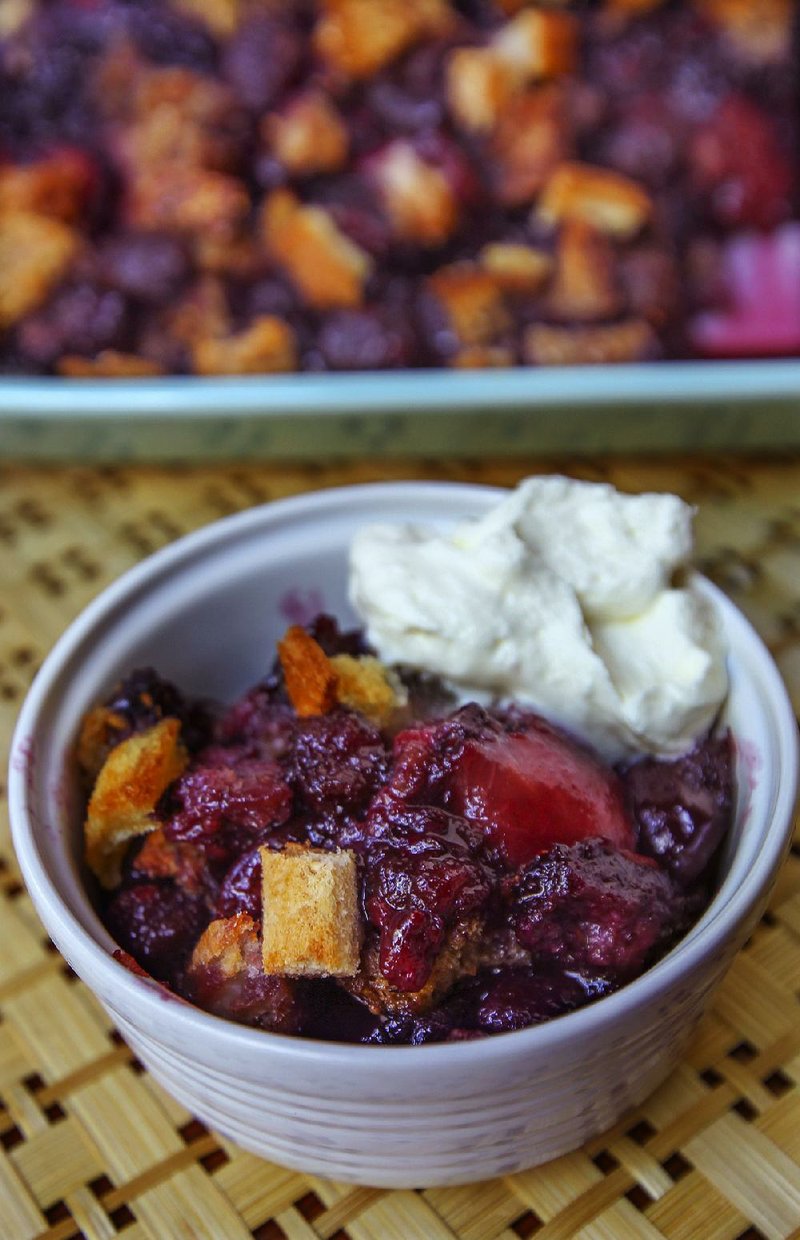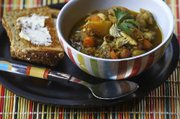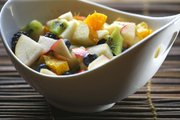I was leaving for a weekend event, with a six-hour drive ahead, and cranky-hungry from getting ready to go without pausing for lunch. I'll just drive through someplace quick on the way out of town, I told myself. Then I looked at the dinner I was packing to eat on the way, and the dim light bulb brightened.
Dinner on the road: hummus with rice crackers, almonds, an apple and a bowl of fresh blueberries, strawberries and raspberries, with unsalted mini pretzels for a snack.
Lunch standing in the kitchen while preparing that dinner for the cooler: mini pretzels with cheese slices, a few black olives, the rest of the strawberries and raspberries, and a couple of dill gherkins. The combination was surprisingly satisfying, and almost all at the ready inside my fridge. Fast, tasty, free.
Our refrigerators and pantries hold the ingredients for a lot more meals than we probably think. And once we learn to forage for ourselves, it's not a huge leap to the adventure of having others over for a meal without having to shop first.
That's how I learned that golden raisins are plump-delicious in soup. A friend was coming for lunch, and there wasn't time for cleaning and shopping. I had chicken in the fridge, and it was a gray drizzly day. I consulted the "One-Pot-Meal Soups" chapter in The Cook's Encyclopedia of Soup, and found mulligatawny. I had most of the ingredients, and could easily substitute those I didn't -- for example, a potato instead of a turnip.
Soup is probably the quintessential "throw something together" meal. It's a great way to use up aging vegetables, and a forgiving way for recipe-bound cooks to experiment. Once, when I was traveling and visited a college friend on short notice, she served "Soup Which Shall Not Be Made Again," featuring some kind of beans, some kind of greens, carrots and onions in a delicious broth, served with crusty bread and cheese.
Since then I've served a few versions of my own "Soup Which Shall Not Be Made Again." The best one I made last winter had kale and potatoes in leading roles and a supporting cast of carrots, onion, celery, tomatoes, black beans and secret herbs and spices, with crispy bacon as a garnish or side dish. With no time to make bread or even cornbread muffins, I served a classic soup companion: saltines, with optional butter.
I felt bad that I hadn't made fresh bread for my neighborhood friends, and said so when they arrived. But one of them was avoiding bread, and the other said, "I was hoping you'd make soup."
It doesn't take a progressive dinner to make a shared meal a collaboration. If a guest asks, "Can I bring anything?" or "What can I bring?" I like to answer, "What do you have?" That allows guests to contribute to the meal voluntarily without spending anything. My soup guests brought homemade macaroons. Others have brought things to co-create a salad.
Some of my happiest times with people around my table have been when people came over for an activity -- playing music, a book club, a writing
group, or some therapeutic coloring. At these gatherings, my main dish is literally, materially a dish: my mother's pressed-glass relish tray.
Cheeses, crackers, olives, pickles, celery and carrot sticks, apple slices, Cutie oranges, mixed nuts, cookies, hard-cooked eggs, even fruitcake in season -- it makes for a tiny buffet of savory, sweet, juicy and satisfyingly crunchy (mostly) finger foods, with small heirloom plates for filling and refilling. And the leftovers become the next day's lunch.
Of course, most-important-meal-of-the-day foods are good any time of day. Eggs, toast, fried potatoes, bacon if you have it, or even just plate after plate of pancakes, are easy and filling and relaxing fare.
Resourcefulness also applies if you are lucky enough and trusted enough to have free range in someone else's kitchen.
If the friends you're house-sitting and dog-sitting for are coming home, and you want something warm and fragrant in the oven to welcome them, while also helping to eliminate some aging fruits and drying bread, but you can't find where they keep the flour, what do you do?
Google "recipe with apples and bread crumbs." Pioneer Woman has one for Apple Brown Betty that looks adaptable. Hers calls for fresh slices of wheat sandwich bread, and brown sugar; so what if there might be only the remains of a crusty artisanal loaf, and you can't find the brown sugar, either; that's part of the art and invention of cooking.
Mulligatawny (aside from being a fun word to say) is a soup that has many variations. My source says it was "introduced into England in the late 18th century by members of the colonial services returning home from India." If this one doesn't appeal, an online search will yield many other possibilities.
Mulligatawny Soup
4 tablespoons butter or oil
1 1/2 pounds bone-in, skin-on chicken pieces OR slightly less boneless chicken pieces OR meat from half a rotisserie chicken
1 onion, chopped
1 carrot, chopped
1 small turnip or potato, chopped
1 tablespoon curry powder or to taste
4 whole cloves, if you have them
6 black peppercorns, lightly crushed
¼ cup lentils, rinsed
3¾ cups chicken or vegetable stock
¼ cup golden raisins
Salt and ground black pepper
If using uncooked chicken, melt the butter or heat the oil in a large saucepan. Add the chicken and brown over a brisk heat. Transfer chicken to a plate; set aside. (If using rotisserie or leftover chicken, add it at the end.)
Add the onion, carrot and other root vegetable to the pan and cook, stirring occasionally, until lightly colored. Stir in the curry powder, cloves and crushed peppercorns and cook for 1 to 2 minutes. Add the lentils.
Pour the stock into the pan and bring to a boil. Add the golden raisins, the chicken and any juices from the plate. Cover and simmer for about 75 minutes.
Remove the chicken from the pan and discard the skin and bones. Chop the meat, return to the soup, and reheat. Check the seasoning, season to taste and serve the soup piping hot.
Makes 4 servings.
Recipe adapted from The Cook's Encyclopedia of Soup, edited by Debra Mayhew, Lorenz Books
A simple honey-lemon drizzle adds a glow to any fruit salad, even if all you have is two fruits in the house.
Apples and Oranges Fruit Salad
3 to 4 cups prepared fresh fruit; use whatever you have on hand: apples, oranges, melons, peaches, pears, berries, bananas
1 tablespoon honey, or to taste
Fresh lemon juice, to taste
Ground ginger, to taste
Wash fruit. Pit stone fruits. Peel those with inedible peels. Cut into bite-size pieces and mix together, reserving tender fruits (raspberries, bananas, kiwi) to add last.
For the dressing, whisk together a tablespoon of honey, a few drops of lemon juice and a pinch of ginger. Taste and add lemon juice if necessary.
Drizzle over fruit; gently stir; add fragile fruits on top.
Makes about 4 cups.
Any dessert called Brown Betty generally involves fruit and sweetened crumbs baked together. I used very dry crusty artisanal bread, and the chunks of bread on top came out looking like Thanksgiving dressing, so "Fruit Stuffing" is probably an apt name, too. All I know is the adults all loved it and immediately had second helpings, and the kids, too young to know the alchemy that turns so-so raw fruit into eyes-roll-back-in-your-head cooked fruit, didn't know what they were missing.
Brown Betty, or Fruit Stuffing
About 8 slices bread
About 6 cups any fresh, frozen or canned fruit (drain, if using canned)
About 3/4 cup butter, plus more for greasing
About 1 1/2 cups brown or white sugar, divided use
Ground cinnamon, to taste
Heat oven to 375 degrees.
Cut bread slices into thin strips. Rotate bread 90 degrees and dice into cubes. Keep cutting, or tearing, if you prefer, until bread is your desired size.
If using fresh fruit, gather aging fruits. Pit or core them. Slice, cut off and discard the brown or mushy parts, and coarsely dice fruit into chunks about the actual size of playing dice. ("Pioneer Woman" Ree Drummond says to peel the apples, but I left the peel on.)
Rub a baking dish lavishly with butter.
Sprinkle brown sugar, or white sugar and cinnamon, in the bottom of the dish. (She says ½ cup but I gave it less.)
Put 1/3 of the fruit over it, then about 1/3 of the bread crumbs (or less, so you have a nice layer of bread crumbs for the end). Repeat: sugar and cinnamon, fruit, bread; sugar and cinnamon, fruit, bread.
Slice some salted butter (she says 1½ sticks; I didn't have that much to work with) and lay the slices all over the top.
Sprinkle 3 to 4 tablespoons of water across the top.
Cover with foil and bake for about 45 minutes. When you have about 5 minutes remaining, remove the foil. Keep an eye on it to make sure it doesn't get too brown. Remove from the oven when it's hot and bubbly.
Recipe adapted from thepioneerwoman.com
Food on 08/17/2016


